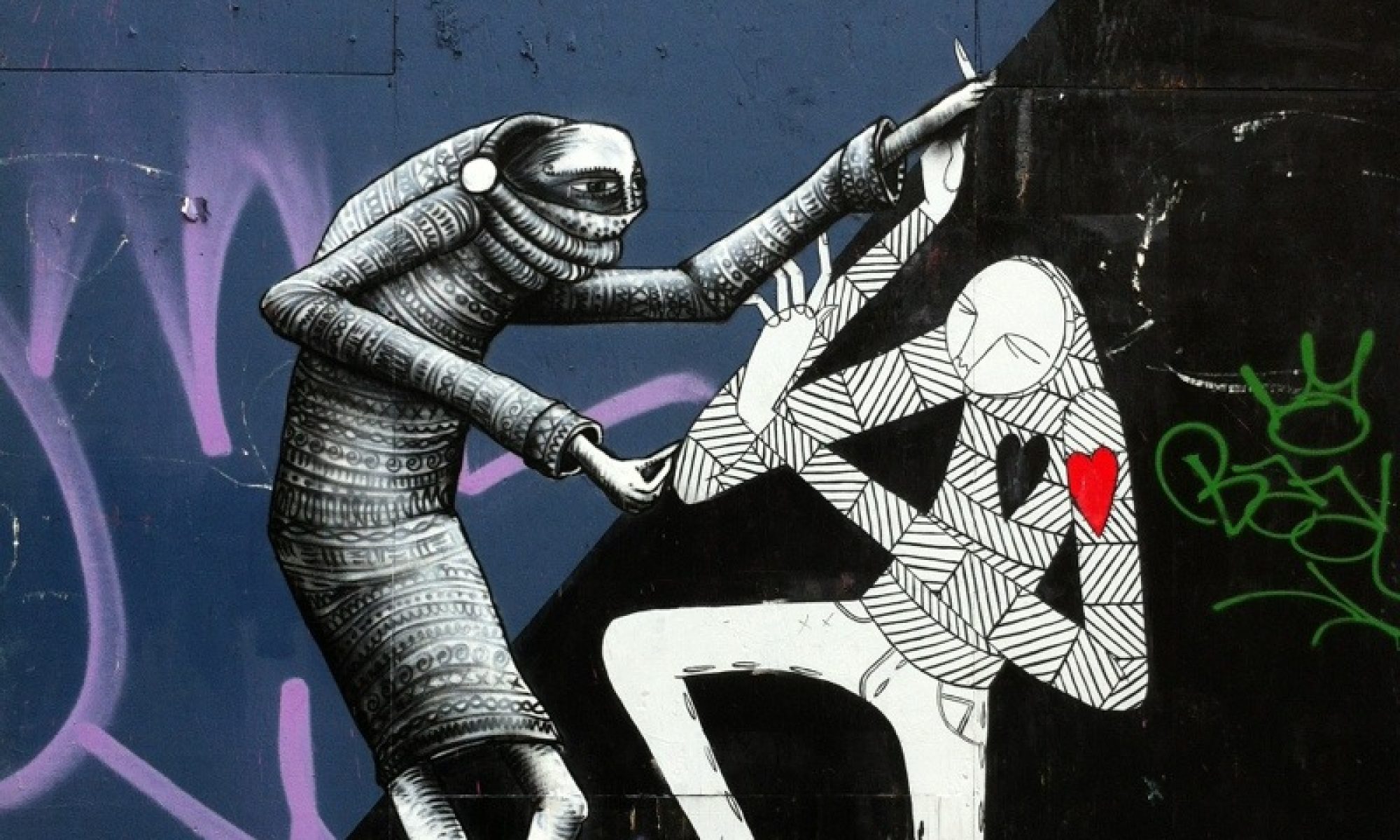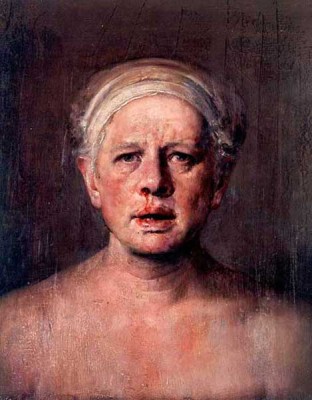Swedish (or Norwegian?) born painter, Odd Nerdrum is one of my favorite painters today. His technique is impressive. In my opinion, he’s today’s Rembrandt. Yes, mind you, his subject matter can be quite explicit and rather blunt, but you can’t ignore his raw talent. He’s up there with the greats.
I was googling him for inspiration…and found a blog post by a painter who had attended a workshop of Nerdrum’s. His post describes Odd’s techniques from canvas stretching, priming, color mixing, and brushwork detail. There are some great moments in this class that the author shares. I loved it and think you should read it (Below).
© Odd Nerdrum – his website
A Class with ODD NERDRUM http://fishingjunk.com/?p=55
3 weeks ago, I went to PAFA for a weekend workshop with Odd Nerdrum. I didn’t quite know what to expect at first. I hauled a 2 bags full of painting gears to philly and I didn’t even paint once. But guess what? it was still worth it.
So what did we do in this 2-day workshop? Most of the time, we watched him paint a portrait of a his student, from start to finish. It took him about 9-10 hours (1.5 days. We actually had the option to paint along side with him, but most people didn’t want to miss out on watching him paint). There was also a performance of Curatoriat (a play he wrote), a slide lecture and a critique session of workshop participants’ works.
Here are some notes I took (not meant to be a comprehensive summary)
Some materials he used in class:
PALETTE:
In the workshop, he used a small (less than 12″ on the longest side) homemade oval shaped palette cut out from foamcore. it was tinted brown.
***
COLORS on the palette:
(Old Holland brand)
-Titanium White w/ a tint of Old Holland Blue (which he pre-mixed into a tube)
-Briliant Yellow Light
-Yellow Brown
-Madder (Crimson) Lake Deep Extra
-Brown Ochre (Deep?)
-Green Umber -Warm Grey (which he pre-mixed from Ti White/ Brown Ochre/ Green Umber)
-Mars Black (warmer and less harsh than Ivory Black)
-Scheveningen Orange? (I think that’s what he used. but I was surprised because I thought this color is fugitive)

CANVAS: He used stretched linen canvas with an unusual weave:

Preparation (his student demoed it in class):
size the canvas with rabbit skin glue. (PVA glue can be used as a substitute).
Priming the canvas:
Materials
-Framer’s Whiting (ground chalk)
-Linseed Oil -Galkyd (just a little bit, to speed up drying time)
-Turpentine (just a litte bit; and do not use OMS) mix with a thick long palette knife until the mix is the consistency of toothpaste. (from I saw, it was more like pancake batter) add white and English Red (or transparent oxide red) so that the final mix is a pinkish brick color. Make sure the canvas is clean (can clean with acetone) before applying the ground onto the canvas. Apply in thin layers, and try to get into the holes. If applying 2 coats, let the first layer tack up first.
The canvas should be ready to use in a week.
You can apply this ground to acrylic gessoed canvas. But Nerdrum said that when using home prepared canvas, it’s already beautiful before you start. you don’t have to fight the ugly flatness of commerically prepared canvas.
***
BRUSHES and PAINT APPLICATION:
Not sure what kind of hair of brush he used, but he used only small sizes (no more than #4) on this portrait.
The brushes he used on the shadows looked like round or filbert. (not sure)
on larger areas, he would use a rag. In fact, he used a rag (and his fingers) a lot.
On light areas and highlights, he mainly used brights, applied a small and decisive stroke with thicker paint and not dragged it around so much. He then blended it out with a rag or finger when necessary.
For final touches, especially in the light areas, he would use a fan brush to lightly layer (the motion is more like gliding) the paint in broad strokes on top of previous layers and let the brush stroke show through.
Occasionally, he would also use a rag or sandpaper to take off paint and let the red imprimatura show through in the shadows.
***
MEDIUM:
From what I saw, he didn’t use medium much. But the medium he used was 50% “cooked” linseed oil (not sure if that means stand oil), 50% turpentine.
***
OTHER TOOLS
-Smoked glass filter (to see value/contrast)
-color gels (to see what an area would look like with more yellow, more green, etc.)
-mirror (to check accuracy)
***
OTHER NOTES ABOUT HIS PAINTING METHOD
He started with a rough outline of the head and went straight to painting shadows, no hard edges in the beginning. During a break on the first day, he used a fan brush to soften the entire face. He turned the painting upside down a couple of times to see where the problem lies. At the beginning of the second day, before starting to paint, he applied a thin layer of linseed oil on the whole surface with the rag (oiling out) he then added green umber to the rag and applied that on the background. (no extra oil, except for the little bit of leftover oil of rag) in the same manner, he applied gold ochre (?) on the whole head, brown on the neck, black on the hair and all over the chin/mouth area.
That’s the only glazing he did. The rest of the time, he painted direct.
***
SOME OTHER THINGS HE TALKED ABOUT (which I am paraphrasing from my notes and to the best of my memory, so please don’t treat them as quotes):
Really good masters can create light even in the shadows.
Monet understands grey.
A lot of the “modern Monets” who copied him failed because they used all these strong colors that clash with each other.
A sky with all blues can look greyer than one that’s painted in black and grays. In the old days, painters didn’t use blue much even for sky because the pigment was so expensive. So they had to learn to make “optical blue” (my words).
A masterpiece should work well in both large and small, and when viewed from left and right.
Light always changes. do the best with the change but don’t fix something that’s not broken.
[when critiquing a still life painting of fruits…] lemons deserve the same respect as human beings (then he quickly said “…maybe I am going too far”). you need to go deeper.
Old masters all had their little faults, beware when you are learning from them. For example, Rembrandt had horrible proportions, Caravaggio was a horrible colorist. Titian painted very badly until he was old. Everybody painted their own mouths. Rembrandt always painted himself even when he was painting other people. Bonnard is not “correct” but he is great because he is a crazy guy.
Andrew Wyeth reinvented reality…he was one of the best painters in America.
I have no respect for people who wants to drag down the human body…it’s important to give people dignity…how? choose a few people you like, care for them, have empathy for them.
All masterpieces are built on trying to emulate someone you admire.
When asked if there are living painters that he likes, he said there are a lot, but he didn’t give names.
It’s important for some representational painters to be famous because they would have some say in the art world.
…………………………………………………
He gave a whole slide lecture on art theory and kitsch. But I’d rather not go into it here because my fragmented notes will not do it justice. But nerdrum did discuss his views at great length on his website.
I have to say that after the workshop, I have deeper respect for Odd Nerdrum. For some reasons, I expected him to be a little more arrogant. But he struck me as a genuinely humble painter (and a very opinionated one, of course). He was also really generous in sharing his knowledge. He even let us pass around his sketchbook (which was amazing) and take photos from it. I just don’t want to publish any of it (and also the finished portrait) without his permission.
All in all, I think it was a great workshop. Would be even better if it were 1-2 days longer, so we could paint and get feedback from him after seeing his full demo. Of course, how much I really learned would only be evident on my future paintings. But since I got back from the trip, I got so caught up with work that all I painted was a oil sketch of a mushroom…and trying to let the imprimatura show through just made it looked like it had too much chilli sauce.
oh well, I will just keep trying.


He is actually Norwegian, he lives in the village I come from in Norway, whenever I am there I see him walking around in his toga.
hmmm. Thats interesting. I’ve read both.
Swedish born? : http://en.wikipedia.org/wiki/Odd_Nerdrum
Norwegian Born? : http://www.oddnerdrum.com/frame_odd.htm
Hey, this is a fantastic post. Very informative. I am a huge fan of Nerdrum and unfortunately a have never seen anything from him in person, just books. I have been painting for five years now since i was fourteen and really love classical painting and I was wonder if there was any way you could share any of your odd nerdrum pics you might have taken in his class of his portrait with me. I will not do such thing as publish and whatnot, I just want to study more the way he paints. I would be very thankful if you could. my e-mail is lavieduneartiste@hotmail.com. Merci!
Early in the discussion it is mentioned not to use OMS, “Odorless Mineral Spirits” what is the problem with it?
Good Question Arthur. I would think we would want to be aware of the toxins around us (by smell) to be reminded to ventilate and close lids, etc., rather than pretend it’s not there and have it cause more damage in the long run. But this is just MY guess… not sure if there’s ingredients in there that might damage the paint.
My guess is to use turps on the ground because it evaporAtes faster than oms…?
thanks for your information, I live in Canada and would never be able to afford a lecture/lesson from Nerdrum. Well what can I say, he is brilliant. Canada birthed Attila Richard Lukas, America Andrew Wyeth and Europe Odd Nerdum, the three most gifted artists who’ve done something universal, political, and creative with enduring realism. Its them who will count in the long run, in fact already, they do today.
Thank you so very much for sharing all this great info on Odd Nerdrum and his painting techniques. Considering I had wanted to sign up for his 2010 PAFA workshop this Fall, but the class was full. So I really appreciate what you have noted down. I had heard he is quite amazing. One of his former students, Natalie Radina Holland, stayed with us back in 2000. Also I have corresponded with one of his models, Trond. They were both so kind in letting me know about Odd and his methods in creating. He’s the “real” thing. Lydia